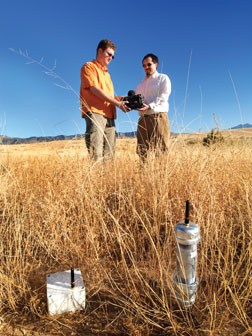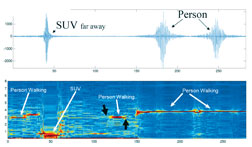NEWS RELEASES
FOR IMMEDIATE RELEASE
December 4, 2006
Sandia researchers develop better sensor detection system
System combines basic off-the-shelf sensors with Sandia-developed sensor
 OUTSTANDING IN THEIR FIELD — Sandia researchers
Jonathan Van Houten (left) and Jeremy Giron hold a Labs-designed
sophisticated sensor that interacts with smaller off-the-shelf
sensors like those seen in the foreground. (Photo
by Randy Montoya)
OUTSTANDING IN THEIR FIELD — Sandia researchers
Jonathan Van Houten (left) and Jeremy Giron hold a Labs-designed
sophisticated sensor that interacts with smaller off-the-shelf
sensors like those seen in the foreground. (Photo
by Randy Montoya)Download 300dpi JPEG image, “sensor-outstanding.jpg,” 1.7MB (Media are welcome to download/publish this image with related news stories.)
ALBUQUERQUE, N.M. — By integrating readily available generic sensors with a more sophisticated sensor, researchers at Sandia National Laboratories have developed a detection system that promises to make it easier to catch perpetrators trying to infiltrate prohibited areas.
The research team, headed by project investigator Hung Nguyen, spent the last four months of FY06 figuring out how small, low-cost, low-power, commercially available sensors can supplement their in-house customized sensors developed between 2002 and 2005. During that time, numerous projects — Target Acquisition, Location, Observation, and Neutralization (TALON), Hard and Deeply Buried Target Grand Challenge (HDBT), Sensor Dart, and Virtual Perimeter System (VPS) — contributed to the advancement of unattended ground sensor (UGS) technology.
As a result, Sandia has solidified a sensor system complete with onboard GPS, compass, local and long haul radios, digital signal processor, and video capabilities. However, it is significantly larger than the off-the-shelf sensors and is not currently available for mass production.
“We wanted inexpensive sensors to act as a first line of defense identifying potential targets and then through a series of radio signals wake up the UGS package. The Sandia-developed UGS package could then use advanced pattern-recognition techniques to classify four-legged animals, two-legged humans, or civilian and military vehicles,” says Nguyen. “The significance of this is that by combining commercial sensors with our UGS, we can cover more ground for less.”
 THE LARGE SOPHISTICATED SENSOR would be placed in the middle of four quadrants surrounded by the smaller off-the-shelf sensors.
THE LARGE SOPHISTICATED SENSOR would be placed in the middle of four quadrants surrounded by the smaller off-the-shelf sensors.Download 300dpi JPEG image, “sensor_map.jpg,” 352K (Media are welcome to download/publish this image with related news stories.)
The integration of the more powerful sensor and the smaller ones will increase detection range, lower false alarms, and increase the area of coverage per dollar spent in complex terrains.
The $75,000 in funding for the off-the-shelf sensor work came through Sandia’s internal Laboratory Directed Research and Development (LDRD) program. It was “late start” money awarded near the end of the fiscal year to help solve a specific problem.
Sandia is a National Nuclear Security Administration laboratory.
The commercial sensors, provided by Crossbow Technology Inc, were modified with Sandia algorithms and some minor hardware changes. They can be powered by either a battery or solar panel, depending on customer needs. The sensor uses a geophone equipped with a four-inch pointed spike planted in the ground to detect movement by measuring seismic waves. To complete the situational awareness package researcher Isaac Toledo describes how the system is both “an elegant and seamless network configuration capable of self-configuring and self-healing.” Any events detected are reported back to the UGS via this network.
“Our customized unattended ground sensors work extremely well for monitoring various situations but for wide areas can be very costly,” says Mark Ladd, manager of Sandia’s Embedded Sensor System Department. “Using the commercial sensors in combination with a handful of our UGS devices is a viable alternate solution.”
 THIS GRAPHIC illustrates data analysis from a Sandia in-house customized sensor, showing advanced pattern recognition identifying an SUV compared to a person. The large sophisticated sensor — complete with onboard GPS, compass, local and long-haul radios, ditigal signal processor, and video capabilities — is supplemented by small, low-cost, low-power, commercially available sensors.
THIS GRAPHIC illustrates data analysis from a Sandia in-house customized sensor, showing advanced pattern recognition identifying an SUV compared to a person. The large sophisticated sensor — complete with onboard GPS, compass, local and long-haul radios, ditigal signal processor, and video capabilities — is supplemented by small, low-cost, low-power, commercially available sensors.Download 300dpi JPEG image, “sensor-suv.jpg,” 448K (Media are welcome to download/publish this image with related news stories.)
Researcher Jonathan Van Houten says one potential application of the sensor system would be to strategically place off-the-shelf sensors at out-of-sight locations around a secure facility. The Sandia UGS would be placed nearby and video-linked to a security station monitored by guards.
“You could put them in arroyos or other places guards can’t immediately see,” Jeremy Giron, another researcher working on the project, says. “If an intruder shows up, the commercial sensors can send a signal to the Sandia UGS, which in turn performs more analysis and notifies the guard via Google Earth.”
Now that the initial integration of commercial sensors with custom UGS has been demonstrated, Ladd is quick to point out that the next logical step is to seek out customers interested in both advancing and deploying this architecture. These sensors will also become part of Sandia’s intrusion detection work.
“We are eager to propel this system to the next level and meet a need that we know is out there,” Ladd says. “Eventually the technology would be transferred to a manufacturer.”
Sandia is a multiprogram laboratory operated by Sandia Corporation, a Lockheed Martin company, for the U.S. Department of Energy’s National Nuclear Security Administration. Sandia has major R&D responsibilities in national security, energy and environmental technologies, and economic competitiveness.
Sandia news media contact: Chris Burroughs, coburro@sandia.gov, (505) 844-0948